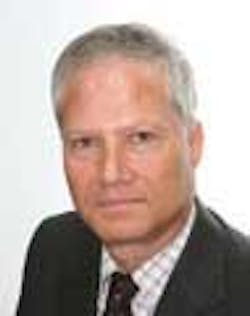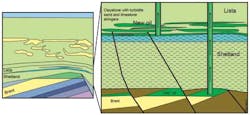Statoil's oil discoveries in the Barents Sea ensured a strong response to Norway's frontier 22nd licensing round. The Petroleum and Energy Ministry has issued 20 new licenses in the Barents Sea and four in the Norwegian Sea to a total of 29 companies.
All Statoil's awards were in the Barents Sea. Its three operated licenses were PL713 in the Bjørnøya basin; PL6158 in the Hoop area, close to an existing license where the company plans to drill two exploration wells in 2014; and PL714, adjacent to the Johan Castberg license, which includes the Skrugard and Havis oilfields.
New operators in the Barents Sea include Centrica, ConocoPhillips, Edison, GDF Suez, RWE Dea and Shell, while Det norske Oljeselskap, Eni, Lundin, Repsol, and Total expanded their interests in the region. Lundin's award was in the southeast of the sector, which has been opened up following resolution of Norway's long-running median line demarcation dispute with neighbors Russia. And two of Russia's leading oil companies, Lukoil and Rosneft, made their debuts as licensees offshore Norway with stakes in Barents Sea blocks.
However, Statoil wants to put on hold an investment decision on the Johan Castberg development, following the government's planned petroleum tax review. The company and partners Eni and Petoro had selected a concept earlier this year for the project, 240 km (149 mi) northwest of Hammerfest in northern Norway. This included building a new oil terminal at Veidnes in Finnmark County. There is uncertainty now over whether the construction would qualify for state aid, as was the case with the LNG terminal nearby in Melkoya, which was built to process gas from the offshore Snøhvit fields.
Irish frontier survey under way
Ireland's government has approved the country's largest regional offshore seismic survey to date, over the Atlantic Margin off the west coast. TheBGP Explorer vessel is performing the 18,000-km (11,184-mi) full-fold 2D program, managed by Eni Ireland in co-operation with the Department of Communications, Energy and Natural Resources. The 145-day campaign is designed to infill data gaps, particularly over the southern Porcupine, Rockall, and Hatton basins, drawing in more bidders for future licensing rounds.
Minister Pat Rabbitte, speaking earlier in a parliamentary debate about a new Joint Committee report on Ireland's offshore oil and gas exploration, said the country had to deal with realities. The country remains under-explored, he pointed out, with only 156 wells drilled offshore compared with over 1,200 offshore Norway and 4,000 in the UK. Norway is the world's second largest gas exporter and seventh largest oil explorer, while Ireland imports over 95% of its gas and 100% of its oil. And the country has only three fields in production compared with over 300 in the UK. So more needs to be done, he said, to increase Irish exploration investment and drilling.
However, the report recommends a doubling of Ireland's existing tax rate on petroleum production, based partly on sustained high oil prices and the impact of advances in technology on exploration success rates worldwide. Neither of these factors gives Ireland a competitive advantage over other areas, Rabbitte said, and without exploratory drilling, the country will have no discoveries. Technology helps, but only wells produce results, he added.
Statoil contracts purpose-designed jackups
Statoil has commissioned three new "Category J" harsh-environment jackups for development drilling in the North Sea. Samsung Heavy Industries will build two of the rigs in South Korea, to be operated by KCA Deutag on the Gullfaks and Oseberg Area fields in the Norwegian sector. They will be designed to provide more efficient drilling and completion of subsea wells compared with existing jackups, Statoil says, and to drill wells up to 10,000 m (32,808 ft) deep. Offshore operations should start in 2016-17.
Noble Corp. will manage the drilling contract for the third new jackup for the heavy oil Mariner field development in the UK northern North Sea. This rig, to be built by Jurong Shipyard in Singapore, will be an enhanced version of Statoil's Cat J specifications, devised originally for operations over a very large platform or for subsea drilling in the Norwegian sector. It will be equipped to deploy either a surface or subsea BOP during drilling.
CNR invites views on platform removal
CNR International has started the public consultation on its plans for decommissioning the Murchison platform and pipelines in the UK northern North Sea. The Murchison field, which also extends into Norwegian waters, is due to cease production early next year. Facilities that may have to be removed include the 24,500-metric ton (27,006-ton) topsides of the platform, installed in 1979 150 km (93 mi) northeast of the Shetland Islands; however, CNR may seek the UK government's help in applying to leave the steel footings in place on the seafloor because of the structure's large size, via derogation status under the OSPAR convention.
More positive news concerns Ninian, another elderly platform complex in the UK far north. Here CNR plans to invest $470 million in life extension measures for the Ninian field, after successfully applying for the UK's Brownfield Allowance. The government introduced this scheme last year following pressure from numerous operators – it provides tax relief on certain fields already in production, allowing incremental projects to go forward that might otherwise be uneconomic. CNR plans to drill four new producer wells and four injectors on Ninian, along with various platform/well upgrades. These measures could allow a further 27 MMboe to be produced.
Elsewhere in this sector, Maersk Oil has restarted production through theGryphon Alpha FPSO, which had to be removed from its offshore location following storm damage in February 2011. Four anchor chains broke, causing the vessel to move off station. The FPSO was transferred to the Damen shipyard in Rotterdam for overhaul/upgrade work on its tanks, process control, power management, and mooring systems.
In the intervening period, Maersk acquired a 4D seismic survey over the wider Gryphon area, and assumed operatorship from BP of Maclure, one of four fields produced via the floater. Once all the fields are fully operational, combined production should exceed 20,000 boe/d, and Maersk plans a high level of drilling activity over the next few years based on results from the new seismic. Within seven years it aims to double its overall UK production to 80-100,000 boe/d.
About the Author
Jeremy Beckman
Editor, Europe
Jeremy Beckman has been Editor Europe, Offshore since 1992. Prior to joining Offshore he was a freelance journalist for eight years, working for a variety of electronics, computing and scientific journals in the UK. He regularly writes news columns on trends and events both in the NW Europe offshore region and globally. He also writes features on developments and technology in exploration and production.



